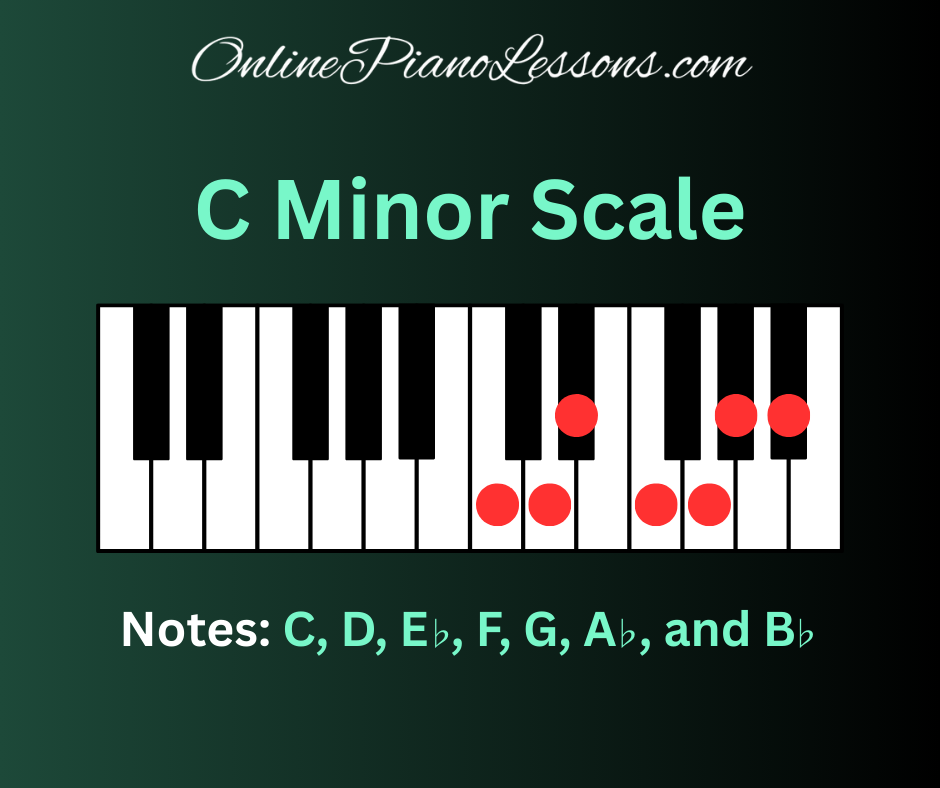
The C minor scale is one of the most widely used scales in classical, jazz, pop, and film music. Its darker, more dramatic sound makes it a favorite among composers and pianists who want to create emotional depth in their music. Whether you’re just beginning to explore scales or are an advanced player working on your technique, learning the C minor scale is essential.
In this definitive guide, we’ll cover what the C minor scale is, the different variations (natural, harmonic, and melodic), how to play it on piano, fingerings, theory, and practical applications in music. By the end, you’ll have everything you need to master this important scale.
What is the C Minor Scale?
The C minor scale is a seven-note scale built from the note C as its tonic (home base). Like all minor scales, it has a more somber or melancholic quality compared to major scales. Minor scales are crucial because they form the foundation for countless pieces of music, from Beethoven’s Symphony No. 5 to modern film scores and pop songs.
There are three main forms of the C minor scale:
- C Natural Minor Scale – the pure form of the minor scale.
- C Harmonic Minor Scale – often used in classical and Middle Eastern-inspired music due to its raised 7th.
- C Melodic Minor Scale – commonly found in jazz and classical music, with a raised 6th and 7th ascending.
The Notes of the C Natural Minor Scale
The formula for the natural minor scale is:
Whole – Half – Whole – Whole – Half – Whole – Whole
Applying this pattern starting on C gives us:
C – D – E♭ – F – G – A♭ – B♭ – C
This is the C natural minor scale, and it’s often the first version students learn.
The C Harmonic Minor Scale
The harmonic minor scale is created by raising the 7th note of the natural minor scale. In C minor, that means raising B♭ to B natural.
C – D – E♭ – F – G – A♭ – B – C
This creates a dramatic step-and-a-half interval between A♭ and B, giving the scale its distinctive, almost “exotic” sound. Many classical composers used the C harmonic minor scale for tension and resolution.
The C Melodic Minor Scale
The melodic minor scale raises both the 6th and 7th notes when ascending but returns to the natural minor when descending (in classical usage).
Ascending: C – D – E♭ – F – G – A – B – C
Descending: C – B♭ – A♭ – G – F – E♭ – D – C
In jazz, however, the ascending form is often used in both directions. The C melodic minor scale is extremely versatile and opens the door to advanced improvisation.
How to Play the C Minor Scale on Piano
Right-Hand Fingering
For the C natural minor scale, one of the most common fingerings is:
- Ascending: 1 (thumb) – 2 – 3 – 1 – 2 – 3 – 4 – 5
- Descending: 5 – 4 – 3 – 2 – 1 – 3 – 2 – 1
Left-Hand Fingering
- Ascending: 5 – 4 – 3 – 2 – 1 – 3 – 2 – 1
- Descending: 1 – 2 – 3 – 1 – 2 – 3 – 4 – 5
Practicing slowly with hands separate, then together, is the best way to gain fluency with the C minor scale.
Chords in the C Minor Scale
The C minor scale is the foundation for building chords. Using the natural minor scale, here are the diatonic triads:
- C minor (Cm) – i
- D diminished (Ddim) – ii°
- E♭ major (E♭) – III
- F minor (Fm) – iv
- G minor (Gm) – v
- A♭ major (A♭) – VI
- B♭ major (B♭) – VII
If you use the C harmonic minor scale, the V chord becomes G major instead of G minor, which creates stronger tension that resolves naturally back to C minor.
Why the C Minor Scale Matters
- Expressive Emotion – Its darker tonality conveys sadness, drama, or passion.
- Improvisation – Jazz players use the C melodic minor scale extensively.
- Classical Repertoire – Many famous works (like Chopin’s Prelude in C Minor, Op. 28 No. 20) use the scale.
- Songwriting – Understanding minor harmony helps songwriters add emotional depth.
- Technical Mastery – Practicing the C minor scale builds dexterity and familiarity with black keys.
Famous Pieces in C Minor
- Beethoven – Symphony No. 5 in C Minor
- Chopin – Prelude in C Minor, Op. 28 No. 20
- Rachmaninoff – Piano Concerto No. 2 in C Minor
Each of these masterpieces shows the power and emotional range of the C minor scale.
Tips for Practicing the C Minor Scale
- Start slowly with a metronome.
- Focus on evenness between both hands.
- Use dynamics (soft to loud) for expressive control.
- Practice all three variations (natural, harmonic, melodic).
- Apply the scale to improvisation and composition.
Final Thoughts
The C minor scale is one of the most powerful and expressive tools for pianists. Its three forms—natural, harmonic, and melodic—each open unique musical possibilities. By practicing the C minor scale regularly, you’ll improve your technique, deepen your understanding of music theory, and gain the ability to express a wide range of emotions at the piano
FAQ About the C Minor Scale
Q: What notes are in the C minor scale?
A: The C natural minor scale is C, D, E♭, F, G, A♭, B♭, and C.
Q: What is the difference between C minor and C major?
A: C major has no flats or sharps, while the C minor scale has three flats (E♭, A♭, B♭).
Q: Which version of the C minor scale should beginners learn first?
A: Most teachers recommend starting with the C natural minor scale before moving to harmonic and melodic variations.
Q: Why does the C harmonic minor sound exotic?
A: Because of the raised 7th (B natural), which creates a step-and-a-half interval with A♭.
Q: How can I use the C minor scale in improvisation?
A: You can improvise over songs in C minor using natural, harmonic, or melodic versions depending on the mood you want.



 I love playing piano, creating new melodies and songs, and further developing my online piano course and making updates/additions to my site OnlinePianoLessons.com!
I love playing piano, creating new melodies and songs, and further developing my online piano course and making updates/additions to my site OnlinePianoLessons.com!  Now that is what I call fun!
Now that is what I call fun!